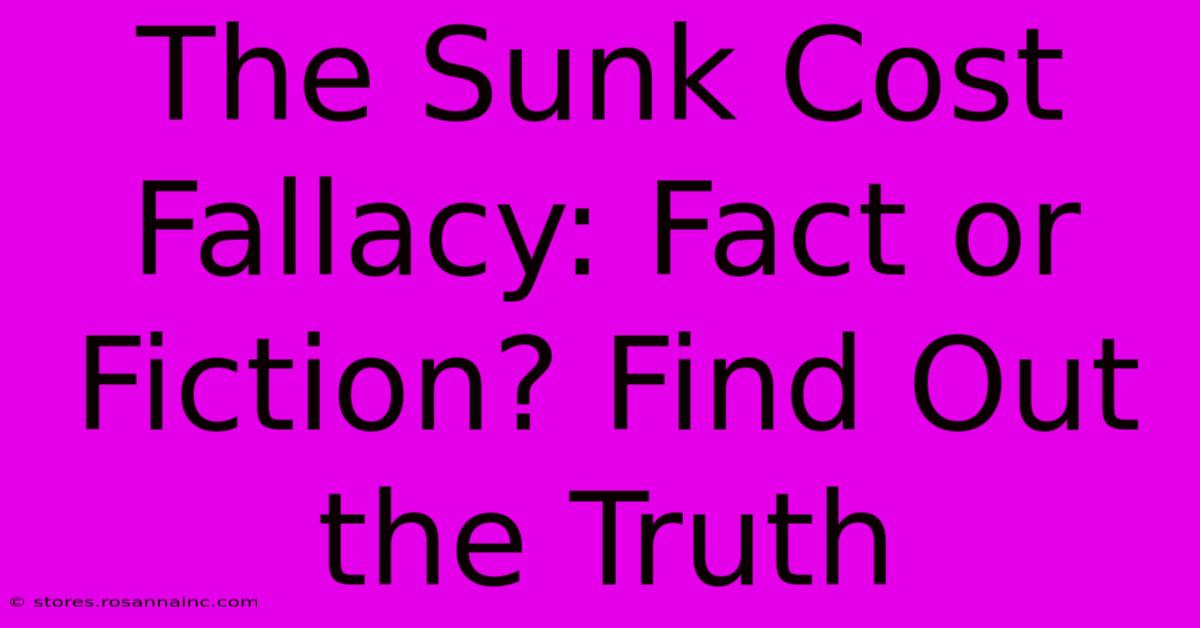The Sunk Cost Fallacy: Fact Or Fiction? Find Out The Truth

Table of Contents
The Sunk Cost Fallacy: Fact or Fiction? Find Out the Truth
We've all been there. You've invested time, money, or effort into something – a project, a relationship, even a bad movie – and despite clear signs it's not working out, you keep going. Why? The dreaded sunk cost fallacy. But is it a real psychological phenomenon, or just a convenient excuse for bad decisions? Let's delve into the truth behind this cognitive bias.
Understanding the Sunk Cost Fallacy
The sunk cost fallacy is the tendency to continue investing in something – be it time, money, or effort – simply because you've already invested in it, even when it's clear that continuing is irrational. These "sunk costs" are past expenditures that cannot be recovered. The fallacy lies in letting these irrecoverable costs influence future decisions. It's throwing good money (or time, or effort) after bad.
Examples of the Sunk Cost Fallacy in Action:
- Finishing a bad movie: You're bored stiff watching a film, but you force yourself to sit through it because you've already paid for the ticket.
- Staying in a failing business: Despite mounting losses, an entrepreneur continues pouring money into a struggling venture because they've already invested so much.
- Persevering in a toxic relationship: You remain in an unhappy relationship because you've invested years and built a life together, even though it's clearly not fulfilling.
- Continuing an education program you hate: You continue with a course of study, even if you’re miserable and it’s not fulfilling your career goals, because of the time and money you’ve already invested.
Why We Fall Prey to the Sunk Cost Fallacy
The reasons behind this common cognitive bias are complex, but some key factors include:
- Loss aversion: People feel the pain of a loss more acutely than the pleasure of an equivalent gain. Cutting losses feels worse than accepting the initial investment as a loss.
- Cognitive dissonance: Continuing to invest in something justifies the previous investment, reducing the discomfort of admitting a mistake.
- Ego and commitment: Quitting often feels like admitting failure, something many people are reluctant to do. We're wired to see things through, even if it means extra pain.
- The desire to avoid wasted effort: The feeling that all the previous effort will be wasted if we stop is a powerful motivator, even if the overall cost of continuing is far higher.
How to Avoid the Sunk Cost Fallacy
Recognizing the sunk cost fallacy is the first step towards avoiding it. Here are some strategies:
- Focus on the future, not the past: Detach your emotional connection to past investments and evaluate the situation objectively. Will continuing to invest bring a positive return on investment, or will it only exacerbate losses?
- Set clear stopping points: Establish criteria for when to cut your losses before you become emotionally invested. This could be a time limit, a financial threshold, or a performance metric.
- Seek external perspectives: Asking trusted friends or advisors for objective opinions can help you see the situation more clearly and avoid emotional biases.
- Practice mindfulness: Be aware of your emotional responses. If you feel pressured to continue because of past investment, take a step back and rationally assess the situation.
- Reframe the sunk cost: Instead of viewing sunk costs as wasted resources, consider them as lessons learned. This can help you move on without dwelling on the past.
The Sunk Cost Fallacy: A Conclusion
The sunk cost fallacy is a very real psychological phenomenon with significant implications for personal and professional decisions. By understanding its underlying mechanisms and implementing strategies to avoid it, we can make more rational decisions and avoid wasting precious resources on failing ventures. Ultimately, the most important consideration is future value, not past expenditures. This awareness is key to breaking free from the sunk cost fallacy's grip.

Thank you for visiting our website wich cover about The Sunk Cost Fallacy: Fact Or Fiction? Find Out The Truth. We hope the information provided has been useful to you. Feel free to contact us if you have any questions or need further assistance. See you next time and dont miss to bookmark.
Featured Posts
-
Orange Roses A Vibrant Canvas For Emotional Expression
Feb 04, 2025
-
Say Goodbye To Ordinary Necklaces Monica Vinaders Exquisite Creations
Feb 04, 2025
-
Unveil The Charm First Communion Invitations That Enchant And Inspire
Feb 04, 2025
-
Unveiling The Secrets Of Rare Artist Trading Card Treasures Discoveries That Will Enchant
Feb 04, 2025
-
Clash Of The Titans Colorado State Vs Utep Who Will Reign Supreme
Feb 04, 2025
